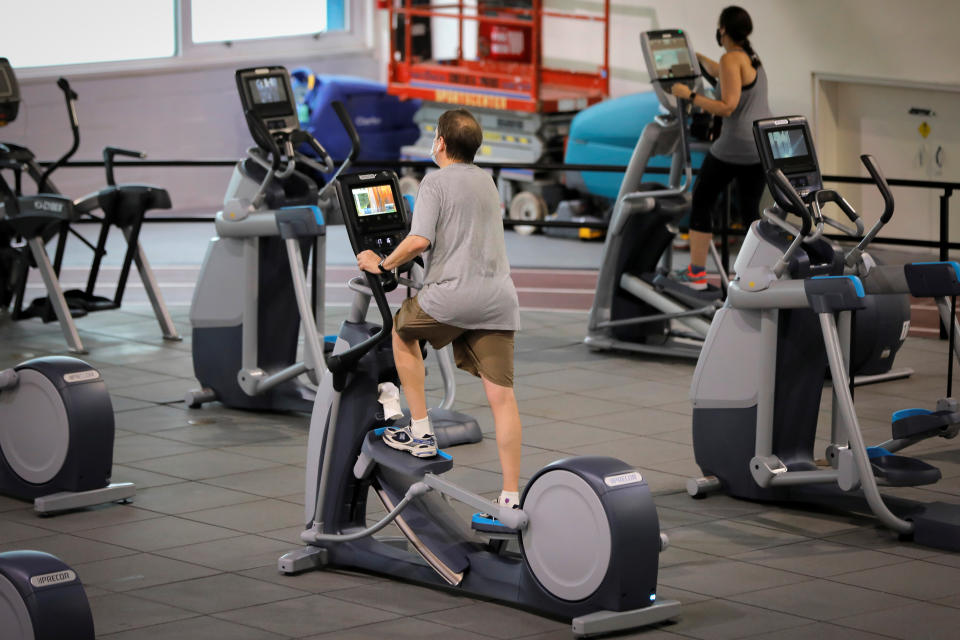Study pinpoints places, from gyms to restaurants, where people are at high risk of contracting COVID-19
For months, places like gyms and restaurants have been linked to outbreaks of COVID-19. Now a new study has determined that these locations and others have been behind most cases of COVID-19 in the United States.
The study, which was published in the journal Nature, used cellphone data to track the hourly movements of 98 million people from 57,000 neighborhoods to points of interest, like restaurants, churches and stores, for two months, starting in March. The location data, which was collected by SafeGraph, a company that aggregates anonymous location data from mobile apps, came from 10 of the largest U.S. cities, including Chicago, Houston, Los Angeles, New York and Philadelphia.

The research team then compared those movements with COVID-19 case counts for each area. Next they used a model to simulate different scenarios, like reopening some venues while others stayed closed. The researchers also estimated COVID-19 infections based on restrictions, or lack thereof, in these areas.
Overall, the researchers determined that opening restaurants at full capacity led to the largest increase in infections. Opening gyms, cafes, hotels and motels at full capacity also created a jump in infections.
On average, the researchers determined that the following locations “produced the largest predicted increases in infections when reopened”:
Full-service restaurants
Gyms
Hotels
Cafés
Religious organizations
Limited-service restaurants
In fact, the study linked more than 80 percent of infections to these locations.
The researchers discovered that minority and low-income people were more likely to leave home more often because their jobs require it and to shop at smaller, more crowded places than those with higher incomes. As a result, the risk of contracting COVID-19 is greater for people in these groups.
It’s not all doom and gloom: The researchers found that putting a 30 percent occupancy cap on all venues could dramatically decrease infections. Infections were further decreased when the cap was at 20 percent.
It’s important to note that this is a model — it didn’t definitively link cases to these spots. Instead it found that the locations are likely to contribute to the spread of the virus.
But there have been real-world examples that suggest the latest findings are onto something. In October, an indoor spin class in Canada was linked to at least 69 cases of COVID-19. In May, the Centers for Disease Control and Prevention shared a case report detailing how up to 87 percent of the members of a choir in Washington state became infected after a 2.5-hour practice alongside a member with COVID-19 who was asymptomatic. And a report published by the CDC in September found that adults who tested positive for COVID-19 were twice as likely to have reported dining out at a restaurant than those who did not contract the virus.
Dr. Amesh A. Adalja, senior scholar at the Johns Hopkins Center for Health Security, tells Yahoo Life that the latest data is an indication of the need for prevention measures at public hot spots. “This makes it clear that when you decrease capacity at a restaurant, there is less spread,” he says. “When you’re in closer proximity, it’s more likely spread will occur.”
Dr. William Schaffner, an infectious disease specialist and professor at the Vanderbilt University School of Medicine, tells Yahoo Life that he is “glad” the results of the study are out “because it reinforces what public health officials have been thinking.”
“Group events with people gathering close together and being carefree or even careless, not wearing masks, singing in houses of worship — those are accelerator events of the virus,” he says. “People then take the virus home and it’s spread in their household or to the neighbor.”
But Adalja stresses that the findings don’t necessarily mean that you should avoid these spots. Instead, he says, the study results show that these are the places that need the most public health interventions. “This is where you want to focus public health efforts,” he says. “Without mitigation, there is a greater risk of spread.”
Of course, not every area has capacity restrictions or regulations on businesses. In September, Florida Gov. Ron DeSantis lifted statewide restrictions on bars and restaurants, allowing them to operate at full capacity. South Dakota Gov. Kristi Noem released an ad in August urging businesses to “grow their company” in her state. “When it comes to supporting growth and eliminating government heavy-handed interference, South Dakota means business,” she said in the ad from the Governor’s Office of Economic Development.
If you live in an area where restrictions are slim to nonexistent, Adalja urges caution about visiting potential COVID-19 hot spots. “If you’re not seeing any change in operations, these environments are not going to be safe places,” he says.
For the latest coronavirus news and updates, follow along at https://news.yahoo.com/coronavirus. According to experts, people over 60 and those who are immunocompromised continue to be the most at risk. If you have questions, please reference the CDC’s and WHO’s resource guides.
How to maintain your physical and mental health during the pandemic
Taking care of a loved one with COVID-19? Here’s how to stay healthy
Q&A with Dr. Kavita Patel: How to keep your family safe and maintain your mental health
Read more from Yahoo Life
Want lifestyle and wellness news delivered to your inbox? Sign up here for Yahoo Life’s newsletter.

